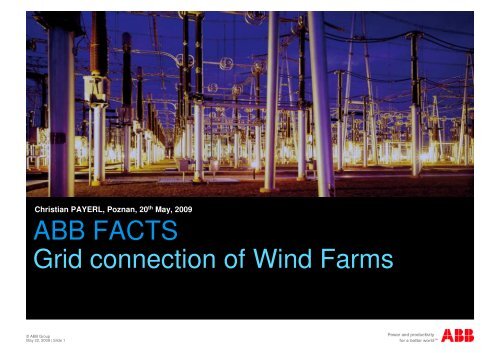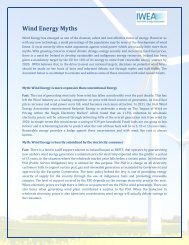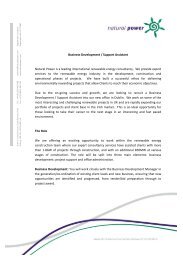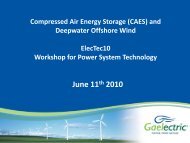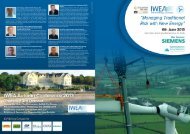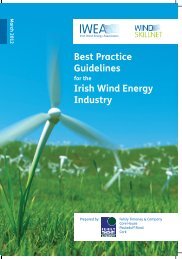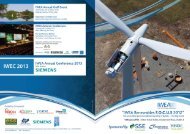Christian Payerl
Christian Payerl
Christian Payerl
You also want an ePaper? Increase the reach of your titles
YUMPU automatically turns print PDFs into web optimized ePapers that Google loves.
<strong>Christian</strong> PAYERL, Poznan, 20 th May, 2009<br />
ABB FACTS<br />
Grid connection of Wind Farms<br />
© ABB Group<br />
May 22, 2009 | Slide 1
FACTS Applications<br />
Flexible AC Transmission Systems<br />
© ABB Group<br />
May 22, 2009 | Slide 4
System Studies - Grid Codes<br />
Background<br />
Many markets are currently installing or discussing<br />
installing large amounts of renewable generation<br />
Of all the renewable energy sources, wind is currently the<br />
most viable technology<br />
In the past wind farms were generally small (ten’s of MWs)<br />
and connected mainly to distribution systems<br />
Today most of the wind farms planned are +100 MWs and<br />
many are being connected to sub-transmission and<br />
transmission level<br />
Why shall large wind plants NOT match the same<br />
demands as other large traditional power plants <br />
This prompts the need for systems analysis in the early<br />
stages of wind farm development to ensure proper<br />
integration into the transmission system<br />
© ABB Group<br />
May 22, 2009 | Slide 11
Grid Connection<br />
Background<br />
Offshore<br />
On-shore S/S<br />
Sub-Sea Export<br />
Cable transmission<br />
Collection<br />
grid<br />
Off-shore HV<br />
Substation<br />
AC<br />
network<br />
Onshore<br />
Reactive Power<br />
Compensation<br />
© ABB Group<br />
May 22, 2009 | Slide 12
Critical aspect, Grid compliance - wind power<br />
General<br />
PICTURE<br />
JPG-FORMAT<br />
WEB OPTIMIZED<br />
RESOLUTION<br />
<br />
<br />
<br />
<br />
<br />
Reactive Power Balance<br />
Voltage Stability<br />
Frequency Control<br />
Fault Ride-Through<br />
Power flow<br />
© ABB Group<br />
May 22, 2009 | Slide 13
Other Advantages with an SVC at the GCP<br />
General<br />
PICTURE<br />
JPG-FORMAT<br />
WEB OPTIMIZED<br />
RESOLUTION<br />
<br />
<br />
<br />
<br />
<br />
Voltage & Transient Stability<br />
Power Oscillation Damping<br />
Load Balancing<br />
Harmonic Mitigation<br />
“Flicker” Mitigation<br />
© ABB Group<br />
May 22, 2009 | Slide 14
Reactive power balance<br />
Reactive Power<br />
Balance<br />
Generators giving local reactive power support are being retired, this<br />
disturbs reactive power balance.<br />
Load sensitivity regarding both fundamental frequency and harmonic<br />
voltages is increased. Customers are more sensitive to outages.<br />
Changed and often reversed power flow calls for studies and actions.<br />
© ABB Group<br />
May 22, 2009 | Slide 19
Possible FACTS Application<br />
Reactive Power<br />
Balance<br />
An SVC at the Connection Point can be used to control the entire, or part of,<br />
the reactive power.<br />
An SVC at the Connection Point makes it possible to minimize the losses<br />
within the wind farm and mitigates the risk for over voltages.<br />
© ABB Group<br />
May 22, 2009 | Slide 21
Voltage Stability, Introduction<br />
Voltage Stability<br />
Historically, wind farms have been excluded<br />
from the demand that generating devices<br />
should contribute to voltage stability. They<br />
cannot, however, expect to enjoy this<br />
favorable treatment forever.<br />
PICTURE<br />
Many regulatory authorities adapt the<br />
requirement that the wind parks should be<br />
able to vary there reactive power output<br />
depending on the grid voltage level.<br />
JPG-FORMAT<br />
WEB OPTIMIZED<br />
RESOLUTION<br />
© ABB Group<br />
May 22, 2009 | Slide 22
Possible FACTS Applications<br />
Voltage Stability<br />
An centrally placed SVC stabilizes the grid.<br />
A solution with an SVC at PCC contribute to voltage stability independent of<br />
the active power production.<br />
© ABB Group<br />
May 22, 2009 | Slide 23
Frequency control<br />
Frequency<br />
Control<br />
As well as for the voltage stability,<br />
new wind generation units are requested<br />
to contribute to frequency stability.<br />
PICTURE<br />
JPG-FORMAT<br />
WEB OPTIMIZED<br />
RESOLUTION<br />
© ABB Group<br />
May 22, 2009 | Slide 24
Frequency control<br />
Frequency<br />
Control<br />
© ABB Group<br />
May 22, 2009 | Slide 25
Possible FACTS Applications<br />
Frequency<br />
Control<br />
Active power needed.<br />
A FACTS device equipped with an energy storage is a possible solution.<br />
Clustering of smaller wind farms into larger production units makes it<br />
easier to apply solutions.<br />
© ABB Group<br />
May 22, 2009 | Slide 26
Fault ride through<br />
Fault<br />
Ride-Through<br />
Minimum fault the system is required to survive.<br />
Symmetric and asymmetric faults.<br />
Depending on voltage level at Connection Point.<br />
Post fault behavior.<br />
Minimum active power as compared to before event.<br />
Reactive power and voltage control.<br />
© ABB Group<br />
May 22, 2009 | Slide 27
Advantages with an SVC at Connection Point<br />
Fault<br />
Ride-Through<br />
<br />
<br />
Fault Ride-Through is first and foremost a question for the Wind<br />
turbine generator manufacturers.<br />
An SVC can have a significant impact on the system after<br />
clearance of the fault.<br />
© ABB Group<br />
May 22, 2009 | Slide 29
SVC Light Energy Storage<br />
Latest development !<br />
<br />
High voltage, high power, STATCOM / SVC Light® Energy Storage.<br />
<br />
The performance and functions of the SVC Light System are expanded<br />
by installing a high voltage, high power, Li-ion battery to the DC side of<br />
the converter.<br />
<br />
ABB are aiming for industry, distribution and transmission level<br />
energy storage applications. Especially the focus is on applications<br />
where the combined use of continuous reactive power control and<br />
short time active power support is needed.<br />
<br />
The new SVC Light Energy Storage System will be introduced to the<br />
market shortly. The first installation is undertaken in cooperation with<br />
a distribution company aiming at learning more about the usefulness<br />
of the system and technology.<br />
<br />
Development of the new SVC Light Energy Storage system started in<br />
2003 and the Lithium Battery technology was selected in 2007.<br />
© ABB Group<br />
May 22, 2009 | Slide 44
SVC Light Energy Storage<br />
Grid connection of renewables<br />
<br />
When connecting large wind farms to the<br />
power grid, these will typically be connected<br />
far away from the large generators in the<br />
system that provides for grid stability and<br />
base power production. Issues such as<br />
voltage control, grid stability during and after<br />
faults and frequency regulation are areas<br />
where the new SVC Light Energy Storage<br />
system will support the wind farm, and the<br />
combined function will to a large extent be<br />
similar to that of a large generator.<br />
Vattenfall: Photo by Hans Blomberg<br />
© ABB Group<br />
May 22, 2009 | Slide 45
SVC Light Energy Storage<br />
Spinning reserve<br />
In a power grid a certain amount of power generation needs<br />
to be in service for back-up, emergency, use. This is<br />
typically referred to as spinning reserve. The amount<br />
differs from area to area, but in general an interconnected<br />
power system needs the same amount available as the<br />
largest unit in order to cope with a loss of the largest<br />
generation unit. The traditional solution is to run<br />
generators below maximum power in order to provide this<br />
capability. The environmental and economical aspects of<br />
this situation are that more than necessary generators are<br />
on-line. If dynamic (almost instantaneous) electrical power<br />
is available from sources such as the SVC Light Energy<br />
Storage the amount of generation on-line can be reduced.<br />
The system will support the grid continuously with reactive<br />
power and in case of loss of generation the system will<br />
push active power into the grid until new generation is online,<br />
typically within 20 minutes.<br />
Vattenfall: Photo by Hans Blomberg<br />
© ABB Group<br />
May 22, 2009 | Slide 46
SVC Light Energy Storage<br />
<br />
Emergency and Peak Power<br />
In a distribution grid or at a sensitive load, an SVC<br />
typically provides for voltage control, filtering of<br />
harmonic and power quality improvements. By adding<br />
energy storage capacity to the SVC a range of new<br />
functions can be added. In cases where the local<br />
loading exceeds the grid capacity the SVC Light Energy<br />
Storage can support the load during a time, the length<br />
being dependent on the size of the battery, typically less<br />
than an hour. Further, in case of loss of power in the<br />
grid, a black-out, a sensitive load or distribution area<br />
can be fed by the SVC Light Energy Storage for the time<br />
until emergency generators are started.<br />
© ABB Group<br />
May 22, 2009 | Slide 47
SVC Light Energy Storage<br />
<br />
<br />
<br />
<br />
<br />
Energy storage connected on DC-side of converter (SVC<br />
Light)<br />
Size depends on power level and duration<br />
Charge energy equal to load energy<br />
Focus on “dynamic”, manages:<br />
<br />
<br />
High number charge and discharge cycles<br />
High Power at medium duration<br />
Chosen high performance battery as energy storage<br />
© ABB Group<br />
May 22, 2009 | Slide 48
SVC Light Energy Storage<br />
<br />
SVC Light<br />
<br />
<br />
<br />
First project in 1999 for flicker mitigation of<br />
electric arc furnace<br />
In total 12 project for both industry and utility<br />
applications<br />
Power range up 164 Mvar, direct connected<br />
without transformer up to 35kV grid<br />
<br />
SVC Light Energy Storage<br />
First project in 2009<br />
<br />
<br />
<br />
<br />
Energy Company in UK<br />
System Voltage 11 kV<br />
Reactive Power:<br />
<br />
600 kVAr inductive<br />
600 kVAr capacitive<br />
Active Power:<br />
<br />
200 kW during 1 hour<br />
600 kW (short time)<br />
Picture of the new Li-ion battery<br />
after testing, October 2008<br />
© ABB Group<br />
May 22, 2009 | Slide 49
© ABB Group<br />
May 22, 2009 | Slide 55


